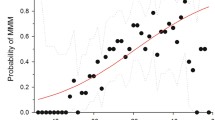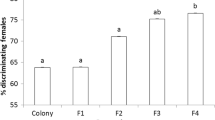Abstract
The Enomopathogenic fungus Entomophthora muscae infects and kills domestic flies Musca domestica, and rates of transmission are higher at high population densities. I tested whether features of parasitized hosts increased the likelihood of transmission of the fungus in a series of experiments. Individual flies contacting an infected conspecific had a much higher probability of becoming infected than had flies contacting a dead fly without signs of infection. Males especially were attracted to and behaved sexually towards dead, infected flies even when a choice was available between a dead, infected fly and a dead, uninfected individual. The abdomen of infected flies swelled considerably as a consequence of infection, and uninfected female flies with larger abdomens are more fecund than the average female and maybe more attractive. Experiments in which abdomens of infected and uninfected flies were cut off and glued back on other flies demonstrated that the abdomens of infected flies were highly attractive to males. When the size of the abdomen of infected and uninfected individual flies was held constant, infected dead flies were still more attractive than corpses of uninfected flies. This result suggests that features other than the size of the swollen abdomen enhanced the attractivity of infected flies. Features of infected hosts therefore increased the likelihood of transmission of the parasitic fungus.
Similar content being viewed by others
References
Bishop YMM, Fienberg SE, Holland PW (1975) Discrete multivariate analysis. MIT Press, Cambridge, Mass
Brobyn PJ, Wilding N (1983) Invasive and developmental processes of Entomophthora muscae infecting houseflies (Musca domestica). Trans Br Mycol Soc 80:1–8
Brodeur J, McNeil JN (1989) Seasonal microhabitat selection by an endoparasitoid through adaptive modification of host behavior. Science 244:226–228
Dawkins R (1982) The extended phenotype. Oxford University Press, Oxford
Day RW, Quinn GP (1989) Comparisons of treatments after an analysis of variance in ecology. Ecol Monogr 59:433–463
Evans HC (1982) Entomogenous fungi in tropical forest ecosystems: An appraisal. Ecol Entomol 7:47–60
Evans HC (1988) Coevolution of entomogenous fungi and their insect hosts. In: Pirozynski KA, Hawksworth DL (eds) Coevolution of fungi with plants and animals. Academic Press, London, pp 149–171
Ewald PW (1980) Evolutionary biology and the treatment of signs and symptoms of infectious disease. J Theor Biol 86:169–176
Ewald PW (1983) Host-parasite relations, vectors, and the evolution of disease severity. Annu Rev Ecol Syst 14:465–485
Ewald PW (1987) Transmission modes and evolution of the parasitism-mutualism continuum. Ann NY Acad Sci 503:295–306
Ewald PW (1988) Cultural vectors, virulence, and the emergence of evolutionary epidemiology. Oxford Surv Evol Biol 5:215–245
Ewald PW (1991a) Transmission modes and the evolution of virulence. Hum Nat 2:1–30
Ewald PW (1991b) Waterborne transmission and the evolution of virulence among gastrointestinal bacteria. Epidemiol Infect 106:83–119
Holmes JC, Bethel WM (1972) Modification of intermediate host behavior by parasites. Zool J Linn Soc 51 (Suppl 1):123–147
Kennedy CR (1975) Ecological animal parasitology. Wiley, New York
King DS, Humber RA (1981) Identification of the Entomophthorales. In: Burges HD (ed) Microbial control of pests and plant diseases. Academic Press, London, pp 107–127
Lobanov AM (1977) Potential fecundity and some questions on reproduction in flies of the family Muscidae. In: Kulemin VV (ed) Insects: vectors of infectious diseases. Ivanovskii Gosudastvennyi Meditzinskii Institut, Ivanovo, pp 46–54
Madelin MIT (1966) Fugnal parasites of insects. Annu Rev Entomol 11:423–448
Moore J (1984) Altered behavioral responses in intermediate hosts: An acanthocephalan parasite strategy. Am Nat 123:572–577
Mullens BA (1985) Host age, sex, and pathogen exposure level as factors in the susceptibility of Musca domestica to Entomophthora muscae. Entomol Exp Appl 37:33–39
Mullens BA, Rodriguez JL (1985) Dynamics of Entomophthora muscae (Zygomycetes: Entomophthoraceae) among naturally infected muscoid fly (Diptera: Muscidae) hosts. Environ Entomol 14:317–322
Mullens BA, Rodriguez JL, Meyer JA (1987) An epizootiological study of Entomophthora muscae in muscoid fly populations on southern California poultry facilities, with emphasis on Musca domestica. Hilgardia 55:141
Ridley M (1983) The explanation of organic diversity. Oxford University Press, Oxford
Samson RA, Evans HC, Latge JP (1988) An atlas of entomopathogenic fungi. Springer, Berlin
Thornhill RA, Alcock J (1983) The evolution of insect mating systems. Harvard University Press, Cambridge
Author information
Authors and Affiliations
Rights and permissions
About this article
Cite this article
Moller, A.P. A fungus infecting domestic flies manipulates sexual behaviour of its host. Behav Ecol Sociobiol 33, 403–407 (1993). https://doi.org/10.1007/BF00170255
Received:
Accepted:
Issue Date:
DOI: https://doi.org/10.1007/BF00170255




